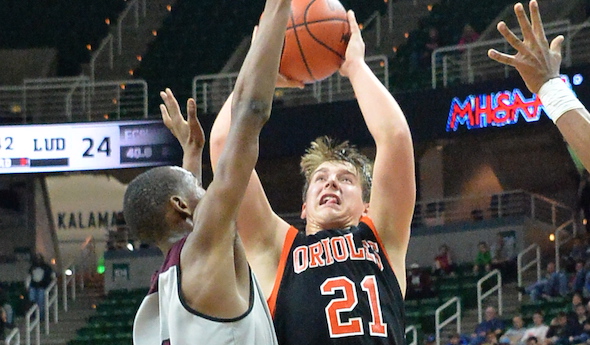
Stunner Sends Ludington to Saturday
March 24, 2017
By Geoff Kimmerly
Second Half editor
EAST LANSING – If older brother is right, Joshua Laman might not remember much of the aftermath of his first 3-pointer this season.
But it’s a shot Ludington – and probably River Rouge – will never forget.
Laman, a sophomore center, had missed all nine of his tries behind the arc entering Friday’s Class B Semifinal. But as the seconds ticked down in overtime, Orioles senior and older brother Noah Laman had the instinct to pass to Joshua stationed in the left corner.
What he tossed up was something of a right shoulder heave, a little like a shot put. But as the final second clicked off the clock, Joshua Laman’s 3-pointer dropped through the net, sending Ludington to its first Class B championship game since 1953 with a 51-50 win over River Rouge.
“I don’t even know if he is thinking right now,” Noah Laman said a few minutes later from the postgame press conference. “I don’t think words can describe what’s going through any of our heads right now."
“He’s thinking that when I get back in that locker room,” Ludington coach Thad Shank added, “he’s going to look Coach Shank in the eye and say, ‘Told you coach I should be shooting these 3s all year long.’ I know that’s what he’s thinking.”
Ludington (25-2) will take on New Haven at 6:30 p.m. Saturday in the season’s final game at the Breslin Center. The Orioles have never won an MHSAA boys basketball title, falling to St. Joseph 60-51 in that lone appearance more than 60 years ago.
This was their first Semifinal since 1971, and they weren’t going to let the opportunity slip by even if they were perceived to be a slight underdog ranked No. 8 heading into the postseason while River Rouge came in No. 2.
It looked for most of the game like the poll was accurate. Although Ludington put together a few runs to keep the game knotted midway through the third quarter, the Panthers (24-2) gradually opened up a lead that reached nine points with 1:48 to play in regulation.
That’s when the first set of heroics came into play. Senior guard and leading scorer Calvin Hackert made two 3-pointers and a free throw, and Noah Laman added the other bucket as the Orioles closed the fourth quarter on a 9-0 run to send the game to overtime.
River Rouge got up by five again midway through the extra period. But Ludington closed on a 7-1 run, with Joshua Laman’s winning shot coming after a Rouge turnover with 30 seconds to play and then two missed shots and offensive rebounds by the Orioles, who otherwise were outrebounded for the game 24-20.
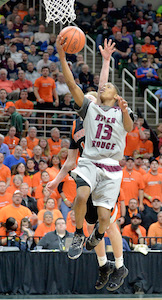
“A couple times I told them hey, if on November 15 when we walked in this gym and we were down four or five points in the state Semifinal to River Rouge, would you take it?” Shank said. “We’ve gotta keep our heads up, and we’ve gotta keep fighting here.
“We are a pressure defensive team, and we have a lot of respect for Rouge and their quickness, and we haven’t played a team with that level of quickness to this point. So we didn’t really aggressively go after River Rouge like we do most teams. But the fact that that’s part of our package I think was huge down the stretch of the game, that that’s what we’re comfortable doing. It wasn’t something we were just throwing out, full court pressure that we’d never used before.”
River Rouge coach Mark White – who previously led Detroit Renaissance to Class A titles in 2004 and 2006 – could sense Ludington was working toward a dramatic end.
He said it was his Panthers’ worst game this season – and obviously the worst time for it. But how Ludington pulled off its last-second success wasn’t lost on him.
“Well, luck is something that’s created. We got a defensive stop, and we teach and emphasize that defense isn’t over until we get the rebound,” White said. “And we didn’t finish the defensive possession. We got them to miss a couple shots, and there were a couple loose balls. It went down to that determination factor, and Ludington wanted it, by their behavior, more than we did … and again, when you give as much as they did, the basketball gods are on your side because you deserve and that happens in March.”
Sophomore Darian Owens-White led River Rouge with 19 points, and junior Jayvien Torrance added 10.
Hackert led Ludington with 20 points, and Joshua Laman had 11. Also worth noting, junior center Will Sadler had seven points, making all three of his shots including his only 3-pointer this winter as well.
Laman’s final shot led to a pile of Orioles players in Breslin’s southwest corner, right in front of a sea of orange-clad fans taking up nearly three full sections of the lower bowl.
“We can tell how big a deal it is just by the support of the community,” Hackert said. “The crowd was electric tonight, and it shows how much they revolve around us and really support us. And to be playing in the state championship, it’s just awesome. I can’t even explain it.”
PHOTOS: (Top) Ludington’s Calvin Hackert puts up a shot as a River Rouge defender works to block his path. (Middle) Rouge’s Darian Owens-White goes up for a layup on the way to scoring 19 points.
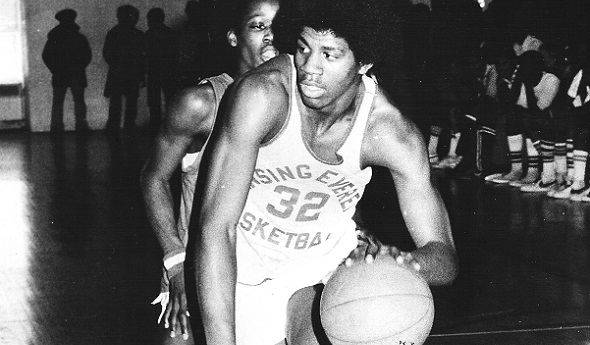
'Retro' Award Rewards 1st Hoops Legends
January 4, 2017
By Ron Pesch
Special for Second Half
Before the start of the MHSAA’s 2009 Boys Basketball finals, Basketball Coaches Association of Michigan director Tom Hursey stopped by my seat at Michigan State University’s Breslin Center to say hello.
Our chat would alter a decade of my Michigan winters.
Somewhere between hello and goodbye, our chat included conversation on one of my favorite BCAM ventures. In 1981, the Michigan High School Basketball Coaches Association, as BCAM was once known, named its first “Mr. Basketball.” I was two years out of high school when Lansing Eastern’s Sam Vincent edged Eric Turner of Flint Central for that first award. Designed to honor the state’s top senior, the award was named in honor of Detroit Free Press writer Hal Schram. “The Swami,” as he was nicknamed, Schram began covering high school sports for the newspaper in 1945.
The 2009 selection was 6-foot-9 Derrick Nix of Detroit Pershing. I mentioned my affinity for the Mr. Basketball program to Tom, but stated that I always thought it a crime that the award didn’t start years earlier, at least when Michigan hoop fans became infatuated with a kid nicknamed “Magic.”
Earvin Johnson prepped at Lansing Everett and was the talk of the state in basketball circles before becoming a household name during his time at Michigan State and with the Los Angeles Lakers. Earlier this year, ESPN named Johnson the greatest point guard to ever play the game. Tom noted that “Magic” was really the inspiration for the “Mr. Basketball” award.
Then I posed a question to Tom.
What about creating a “new” award, designed to honor those greats from the past?
As my hobby of researching the history of high school sports in Michigan and beyond had grown over the years, I’d found the Great Lakes state had always produced shining stars on the basketball court. The crime was that the “Mr. Basketball” award hadn’t been launched many years before.
Harry Kipke, was perhaps the state’s first true basketball star. He won 12 varsity letters at Lansing Central and guided the basketball team to the semifinal round of the state tournament in 1920 as a senior, before heading to the University of Michigan where he earned letters in football, basketball and baseball. After stops at the University of Missouri and Michigan State, Kipke would serve as Michigan’s football coach, guiding the Wolverines to two national gridiron championships.
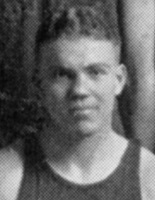 As a junior, the basketball antics of Grand Rapids Union’s Royal “Red” Cherry captured the state’s attention when he led Union to the state basketball championship. Considered the best all-around player of the tournament, Cherry led the team to a second consecutive title as a senior. He, too, attended Michigan, earning laurels on the basketball court and the baseball diamond.
As a junior, the basketball antics of Grand Rapids Union’s Royal “Red” Cherry captured the state’s attention when he led Union to the state basketball championship. Considered the best all-around player of the tournament, Cherry led the team to a second consecutive title as a senior. He, too, attended Michigan, earning laurels on the basketball court and the baseball diamond.
Many other legends of the hardcourt populated Michigan’s past: Saginaw’s Ernie Thompson; the Burton brothers, M.C. and Ed, of Muskegon Heights; Detroit Pershing’s Ralph Simpson and Spencer Haywood; Dave DeBusschere of Detroit Austin Catholic; Willie Betts and Blanche Martin of River Rouge; Ron Kramer of East Detroit; Benton Harbor’s Chet Walker and L.C. Bowen.
After a few weeks of research, discussion and thought, Tom agreed, and over the next several months the framework for the “Retro Mr. Basketball” project was developed
The idea was to try and mimic the current model. Only seniors, and their high school basketball careers, should be considered. While any “senior” player would be eligible, a ballot of the state’s elite would comprise the candidates for the award. Like their modern-day equivalents, where the events of life that would follow high school graduation had yet to occur, post-high school life would be disregarded as much as possible for “Retro” candidates.
Finally, the program would follow a 10-year arc, kicking off in the spring of 2010. This December marks my eighth year of research tied to the mission. Two more will follow.
Since the Schram “Mr. Basketball” award began in 1981, the “Retro” award would honor basketball players from the years 1920 through 1980. That first year, a ballot comprised of players from the years that ended in zero - 1920, 1930, 1940, 1950, 1960, 1970 and 1980 – was created. A senior for each year would be named the winner of the “Retro” award. That meant with the selection of “Mr. Basketball” and the six “Retro” winners for the years 1929, 1939, 1949, 1959, 1969 and 1979, scheduled for the spring of 2019, BCAM would be able to point to a combined list of Mr. Basketballs totaling 100 of the state’s finest.
To identify each year’s award winner, a committee of veteran BCAM members was formed to study a ballot of candidates and select a winner.
Technology, combined with scanning old-fashioned reels of microfilm, has helped with research of potential candidates. In those very early years, personal statistics were rarely kept. Rather, an assessment of a player’s skills, tied to the position he played, often served as a means to identify an area’s top athletes. Tournament play was often the only time an athlete’s abilities were on display to a larger audience. Scouring newspaper articles for all-tournament teams and yearbooks for additional details and years of study helped uncover the state’s top senior players. Understanding the game and its evolution was important. The center jump after each basket emphasized the importance of a tall, skilled center in those games played before the winter of 1938-39.
Beginning in 1935, all-state teams began to appear in state newspapers. Eventually, the Detroit Free Press, the Detroit Times, the Detroit News, The Associated Press and even United Press International became involved in identifying the state’s top basketball players and naming all-state squads. Much work is involved in parsing the 15,811 names (not including honorable mentions) found in those lists. When duplicates are removed, the names of 8,430 prep players remain spread over the 61 years that mark the “Retro” field of possible candidates.
Research to identify seniors, players named by multiple media outlets, and mini biographies are compiled for the top players. The field of candidates is then narrowed to 10 or fewer. Over state championship weekend, the ballots are brought to the BCAM committee for discussion, and finalists are named for each year. Finally, one player is named for each eligible season.
Like the modern day award, the selection may create some controversy. Some amazing ballplayers have landed on the finalist list, but were denied the Hal Schram Mr. Basketball award: Traverse City’s Dan Majerle, Roy Marble of Flint Beecher, Detroit Southwestern’s Jalen Rose, Detroit Northern’s Derrick Coleman and Draymond Green of Saginaw are among a few.
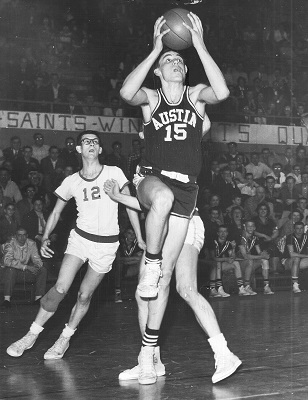 The same applies to the “Retro” list. Fennville’s Richie Jordan, Robert “Bubbles” Hawkins from Detroit Pershing, Dennis Bankey of Detroit St. Thomas, Bill Chmielewski of Detroit Redeemer, Highland Park’s Terry Duerod and Detroit Kettering’s Lindsay Hairston all have been honored on the finalist lists, but fell short of the top prize.
The same applies to the “Retro” list. Fennville’s Richie Jordan, Robert “Bubbles” Hawkins from Detroit Pershing, Dennis Bankey of Detroit St. Thomas, Bill Chmielewski of Detroit Redeemer, Highland Park’s Terry Duerod and Detroit Kettering’s Lindsay Hairston all have been honored on the finalist lists, but fell short of the top prize.
In many cases, Michigan was loaded with prep talent – it’s tough to name Roy Marble Mr. Basketball when Flint Northwestern’s Glen Rice was on the same ballot, or Rose the state’s best when Country Day’s Chris Webber was another candidate. While the “Fennville Flash” amazed the state with his eye-popping statistics in 1965, Bowen led Benton Harbor to back-to-back Class A titles. Named an all-state basketball player as a junior, Hairston grew an inch and improved his game as a senior, but Pontiac Central’s “Campy” Russell dominated headlines that season, and was the “Retro” Mr. Basketball selection for 1971.
In some cases, it’s a challenge to look at the final balloting results without judging selections based on future basketball success. That certainly is the case with 2008. That season, Michigan’s Mr. Basketball award went to 6-foot guard Brad Redford, who posted incredible back-to-back high school seasons at Frankenmuth. Runner-up to the award that year was Saginaw’s Green. Considering Green’s success in the NBA, that’s hard for many to believe.
While the debates may never be settled, the beauty of Schram and “Retro” Mr. Basketball balloting can be found in the argument. With those disputes, people recall, research and learn about Michigan’s incredible prep basketball past.
The remaining three years of the “Retro” project will include many more legends of Michigan High School basketball, including, among others, DeBusschere, Walker, Haywood and Simpson.
This season, that “Magic” kid will be one of the names among the mix. Forty years after high school graduation, will he earn the honor that eluded him in high school, only because the honor didn’t yet exist?
 Ron Pesch has taken an active role in researching the history of MHSAA events since 1985 and began writing for MHSAA Finals programs in 1986, adding additional features and "flashbacks" in 1992. He inherited the title of MHSAA historian from the late Dick Kishpaugh following the 1993-94 school year, and resides in Muskegon. Contact him at [email protected] with ideas for historical articles.
Ron Pesch has taken an active role in researching the history of MHSAA events since 1985 and began writing for MHSAA Finals programs in 1986, adding additional features and "flashbacks" in 1992. He inherited the title of MHSAA historian from the late Dick Kishpaugh following the 1993-94 school year, and resides in Muskegon. Contact him at [email protected] with ideas for historical articles.
PHOTOS: (Top) Lansing Everett’s Earvin Johnson drives around a defender during his celebrated high school career. (Middle) Grand Rapids Union’s Royal “Red” Cherry. (Below) Detroit Austin Catholic’s Dave DeBusschere drives to the hoop as an opponent gets in position to rebound. (Photos from MHSAA and Ron Pesch historical files.)

